
About UsThe Numismatic Bibliomania Society is a non-profit organization promoting numismatic literature. For more information please see our web site at coinbooks.org SubscriptionsThose wishing to become new E-Sylum subscribers (or wishing to Unsubscribe) can go to the following web page link MembershipThere is a membership application available on the web site Membership Application To join, print the application and return it with your check to the address printed on the application. Membership is only $15 to addresses in the U.S., $20 for First Class mail, and $25 elsewhere. For those without web access, write to: David M. Sundman, Secretary/TreasurerNumismatic Bibliomania
Society AsylumFor Asylum mailing address changes and other membership questions, contact David at this email address: dsundman@LittletonCoin.com SubmissionsTo submit items for publication in The E-Sylum, just Reply to this message, or write to the Editor at this address: whomren@coinlibrary.com
BUY THE BOOK BEFORE THE COINYou won't regret it! |
- WAYNE'S WORDS: THE E-SYLUM DECEMBER 21, 2008
- UPDATE: 100 GREATEST WORKS OF AMERICAN NUMISMATIC LITERATURE
- LAKE BOOKS 96TH NUMISMATIC LITERATURE SALE
- NEW BOOK: THE ATHENIAN DECADRACHM BY WOLFGANG FISCHER-BOSSERT
- NEW BOOK: PIONEER MINOR COINAGE OF AMERICAN SALOONS BY FRED HOLABIRD
- EXHIBIT: THE AMERICAN NUMISMATIC SOCIETY LIBRARY: 150 YEARS OF LEARNING
- IMPERIAL COINS' EMAIL NUMISMATIC NEWSLETTER
- LEARNING TO NAVIGATE NUMISMATIC LITERATURE
- NUMISMATIC NEWS PUBLISHER SCOTT TAPPA ON THE KRAUSE LIBRARY
- MORE ON CORNELIUS C. VERMEULE
- MORE ON GEORGE GROSLIER
- ON BOOKS THAT CONTAIN EXAMPLES OF THE NOTES BEING CATALOGED
- QUERY: CSA SILVER INGOT INFORMATION SOUGHT
- MERRY CHRISTMAS: SANTA CLAUS ON PAPER MONEY
- ARTICLE DESCRIBES NUMISMATIC EVIDENCE OF THE STAR OF BETHLEHEM
- QUERY: TED TURNER AND NUMISMATIC NECKWEAR
- SUBSCRIBER PROFILE: JON RADEL
- IRAQI SHOE-THROWING INCIDENT: SHADES OF THE WASHROOM WARRIOR
- ARTICLE PROFILES LOUISIANA COIN DEALER PAUL HOLLIS
- SOUTH KOREA CANCELS PLANNED BANKNOTE OVER MAP MIXUP
- FEATURED WEB SITE: TASMANIAN PROMISSORY NOTES
WAYNE'S WORDS: THE E-SYLUM DECEMBER 21, 2008
 Among our recent subscribers is Angel Navarro, courtesy of Serge Pelletier. Welcome aboard! We now have 1,228 subscribers.
Among our recent subscribers is Angel Navarro, courtesy of Serge Pelletier. Welcome aboard! We now have 1,228 subscribers. This week we open with a short update on the 100 Greatest Works of American Numismatic Literature survey, word of Fred Lake's sale of the Charles Hoskins library, and announcements of two new books. Other articles discuss the numismatic libraries at the ANS and Krause Publications.
In keeping with the holiday season we have a special exhibit of Santa Claus notes and a new article about Mike Molnar's Star of Bethlehem book. To learn about Tasmanian Promissory Notes, read on. Have a great week, everyone, and Merry Christmas!
Wayne Homren
Numismatic Bibliomania Society
UPDATE: 100 GREATEST WORKS OF AMERICAN NUMISMATIC LITERATURE
Fred Reed writes:I checked with compiler Len Augsburger, who writes:
LAKE BOOKS 96TH NUMISMATIC LITERATURE SALE
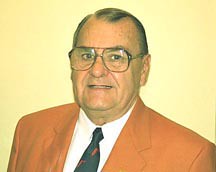 Fred Lake writes:
Fred Lake writes: The 388-lot sale features selections from the library of Charles Hoskins, a well-known coin authenticator and grader. All facets of the numismatic experience are covered with reference material on U.S. coinage, World coins, Paper Money, Tokens, Exonumia, etc.
The sale closes at 5:00 PM (EST) on January 20, 2009 and bids may be placed until the closing time via email, telephone, fax, or regular mail.
Joan and I wish everyone a very Merry Christmas and a Happy Holiday season.
NEW BOOK: THE ATHENIAN DECADRACHM BY WOLFGANG FISCHER-BOSSERT
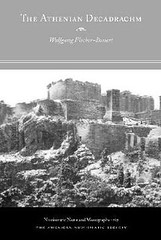 The Athenian Decadrachm is the first monograph in over 35 years in any language to study the coinage of classical Athens. It collects for the first time the evidence for the largest denomination ever produced by the Athenian state, the ten-drachma piece, and situates the coinage within its social, political and economic background. This book represents a huge advance on the previous study of the material, Chester Starr’s Athenian coinage, 480-449 B.C. (Oxford, 1970).
The Athenian Decadrachm is the first monograph in over 35 years in any language to study the coinage of classical Athens. It collects for the first time the evidence for the largest denomination ever produced by the Athenian state, the ten-drachma piece, and situates the coinage within its social, political and economic background. This book represents a huge advance on the previous study of the material, Chester Starr’s Athenian coinage, 480-449 B.C. (Oxford, 1970).Fischer-Bossert has collected more than three times as many specimens as were known to Starr, and has provided a full account of the known forgeries drawn from the photo-files of major dealers, scholars and museums. A die-study of forty genuine Athenian decadrachms in public and private collections is provided, together with a catalogue of more than ninety modern forgeries. Almost all are illustrated. This will be an indispensable work for all interested in the coinage and history of 5th-century Athens. In addition, its judicious discussion of the history of the forgery of these remarkable coins will make this volume a handbook for all serious collectors of ancient Greek coinage. The Athenian Decadrachm is number 168 in the Numismatic Notes and Monographs Series.
A pre-publication discount is available on the American Numismatic Society's upcoming book: The Athenian Decadrachm by Wolfgang Fischer-Bossert. The discount is available only to orders postmarked by December 31, 2008. After December 31st, the price for this title will be $95 for non-members and $66.50 for members. http://numismatics.org/wikiuploads/NewsEvents/AthenDecadrOrder_by_dec31.pdf
NEW BOOK: PIONEER MINOR COINAGE OF AMERICAN SALOONS BY FRED HOLABIRD
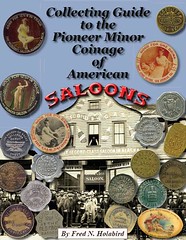 Saloons are as much a fixture of the American West as cowboys, Indians and six-shooters. Saloon tokens are some of the most sought-after tokens or coins by collectors today. They have existed for a millennia and once included many types of businesses such as coffee houses, restaurants, ice cream parlors, road houses, bars, taverns, billiard halls, and brothels.
Saloons are as much a fixture of the American West as cowboys, Indians and six-shooters. Saloon tokens are some of the most sought-after tokens or coins by collectors today. They have existed for a millennia and once included many types of businesses such as coffee houses, restaurants, ice cream parlors, road houses, bars, taverns, billiard halls, and brothels.This book primarily deals with the pioneer minor coinage associated with the pre-Prohibition saloon. Merchants used “tokens,” a form of money or pioneer minor coinage as both change and advertising. The majority of American saloon tokens got their start during the Civil War, primarily from coffee house-type saloons.
In the west, the use of the saloon token took off in the 1870s and was in wide usage by the late 1890s. The great discoveries of gold in Virginia City, Tonopah and Goldfield in Nevada, coupled with the Cripple Creek discoveries of the 1890s created a massive influx of miners into remote regions of the American West after 1900.
The majority and use of all American saloon tokens come from this period, which extended over the next decade and expanded at an enormous rate until anti-saloon sentiment began to sweep the country. Prohibition put an end to the old west style saloon. Though there are many of post-Prohibition saloon tokens, they are not the focus of this book.
What is a Saloon Token?
Most will argue that a true saloon token must state the word “saloon” somewhere on the piece, however there really was no distinction between a bar and a saloon in the Wild West. Furthermore, once prohibitive alcohol laws started to take a stronghold, business owners dropped the word “saloon” to continue to operate below the radar of Federal or local laws.
Beginning around the second decade of the 1900s, true saloon tokens began to decrease in number. Tokens that carry the word “saloon” from this time period are extremely rare (except in the west, such as in California and Nevada), though many varieties of tokens from other bars can be found. Surely a great deal of them maintained a “speakeasy” as part of their business. It is safe to say that there are at least twice as many saloon tokens known that did not use the word “saloon” than what has been documented as true saloon tokens inclusive of that famous word, “saloon.”
Cock A Too Saloon, Paradise, Arizona
Our House Saloon, Yuma, Arizona
Wigwam Saloon, Jerome, Arizona
Cuthroat Saloon, Markeeville, California
Old Tub Saloon, Bardstown, Kentucky
Frigid Zone Saloon, Sidney, Montana
Last Chance Saloon, Billings, Montana
Bucket of Blood Saloon, Virginia City, Nevada
Dummy Line Saloon, Austin, Texas
Top Ten Funny Saloon Names (http://www.holabirdamericana.com/FavoriteTokens.html)
EXHIBIT: THE AMERICAN NUMISMATIC SOCIETY LIBRARY: 150 YEARS OF LEARNING
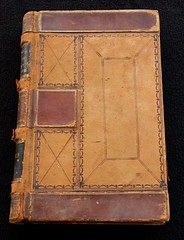 When the ANS Library first began to acquire items for the collections, they were documented in these large, 9.5”x 14” volumes. This volume contains the first 40 years of entries, which list the “title”, “author”, “style” (i.e. publisher), “donors etc.”, and “when” the item was acquired. The first line of the book lists the Library’s first acquisition from 1859...
When the ANS Library first began to acquire items for the collections, they were documented in these large, 9.5”x 14” volumes. This volume contains the first 40 years of entries, which list the “title”, “author”, “style” (i.e. publisher), “donors etc.”, and “when” the item was acquired. The first line of the book lists the Library’s first acquisition from 1859...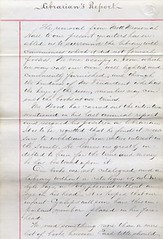 This three-page report was generated by Mr. Richard Hoe Lawrence, who served as the Librarian of the American Numismatic Society from 1880-1886. In his report, transcribed here, he laments the resignation of the previous librarian, Mr. Isaac F. Wood, who had served as the Society’s Librarian since 1869, and stresses the need for a catalog of the collections. Three years after this report was generated, there appeared the first catalog of books in the collections of the ANS, which was published in 1883.
This three-page report was generated by Mr. Richard Hoe Lawrence, who served as the Librarian of the American Numismatic Society from 1880-1886. In his report, transcribed here, he laments the resignation of the previous librarian, Mr. Isaac F. Wood, who had served as the Society’s Librarian since 1869, and stresses the need for a catalog of the collections. Three years after this report was generated, there appeared the first catalog of books in the collections of the ANS, which was published in 1883. To read the complete article, see: The American Numismatic Society Library: 150 Years of Learning (http://www.numismatics.org/Library/NowOnView)
| FEATURED IN OUR JANUARY 10, 2009 NEW YORK PUBLIC AUCTION SALE JONTHAN SWIFT'S 1724 DEFENCE OF THE CONDUCT OF THE PEOPLE OF IRELAND IN THEIR UNANIMOUS REFUSAL OF MR. WOOD'S COPPER-MONEY GEORGE FREDERICK KOLBE Email: GFK@numislit.com Tel: (909) 338-6527 | 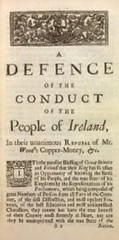 |
IMPERIAL COINS' EMAIL NUMISMATIC NEWSLETTER
If you are not subscribed yet you can do so right from our homepage at: http://imperialcoins.com
In this issue:
- Grading Ancient Coins (A comparison by type) By: Alfredo De La Fe
- Colin Kraay's Explanation of the Phenomenon of Overstruck Reverses on Roman Imperial and Provincial Coins By: Curtis Clay
- Money Minting Brits: Coin Clipping in Late/Post Reform Britain by: Keith Nurse
- Pro Mn. Fonteio C. f. by: Mark Passehl
- The Technical Obverse: Another Archaic Convention by: Wayne Sayles
- The Cornucopia Served as a Jewish Symbol by: David Hendin
- Ancients in the news - News articles of interest to Ancient Numismatists
To subscribe to the newsletter, go to: Imperial Coins and Artifacts (http://www.imperialcoins.com/intro.asp)
LEARNING TO NAVIGATE NUMISMATIC LITERATURE
ANS members can get permission to sit in on some of the lectures. The ones I attended were quite good!
A numismatic researcher needs to understand the techniques of numismatics and be able to find out what other scholars have written on the subject. There is very little written on how to do good numismatic research. You won't find courses at your local college explaining how to use Clain-Stefanelli's Numismatic Bibliography. Your local library probably doesn't even have it! How does a collector who isn't a graduate student learn to navigate numismatic literature?
Take a look at the Seminar reading lists. The lists reveal the books the ANS curators feel provide the numismatic background to get started with serious research.
To view the reading lists, see: Reading Lists for Incoming Graduate Summer Seminar Students
To read the complete article, see: Reading List for the Eric P. Newman Graduate Seminar in Numismatics (http://digitalhn.blogspot.com/2008/12/reading-list-for-eric-p-newman-graduate.html)
NUMISMATIC NEWS PUBLISHER SCOTT TAPPA ON THE KRAUSE LIBRARY
Upon entering the main lobby, you encounter a cased display of Red Feather Money from the Solomon Islands. In the corner is a Norman Rockwell painting of a numismatist called "The Collector." Past the front desk is a large plaque listing all winners of the Numismatic Ambassador Award, and a Coin of the Year trophy. Take five more steps and you'll see a framed copy of the first Numismatic News.
Further into the building is our library. A numismatist could spend a year in there and still leave wanting more.
Numismatics is all around us here at KP, and in Iola as well. If you have any appreciation of history, it's easy to see that none of us in this company would be here today if Chet Krause hadn't launched Numismatic News in 1952. Perhaps many of you reading this publication wouldn't be involved in this hobby to the extent that you are now if not for Chet's creation.
It is with this appreciation of what has come before that I have entered the role of publisher of KP's numismatics group. It is an honor to serve such a rich hobby of dedicated enthusiasts, and to serve them alongside the hard-working, knowledgeable members of our staff.
I am not a numismatist. From my past dealings with our numismatic online properties I have a working knowledge of some basic terms, but most of my education in this field will be on the job - and I intend to get the best education possible!
Now I have the privilege of leading what our management has termed our numismatics community. The community approach to organizing the company is a novel one that has drawn praise both from employees and media industry observers.
In a departure from our old structure, under the new setup one community leader oversees everything in that subject area. For numismatics, that includes Numismatic News, Coins, Coin Prices, Bank Note Reporter, and World Coin News; our entire outstanding book line; the Chicago International Coin Fair, Chicago Paper Money Expo, and MidAmerica Coin Expo; and NumisMaster.com, NumismaticNews.com, and our e-mail newsletters.
The last few weeks have been a crash course for me, learning as much as possible about our products, the hobby, and our products' place in the hobby. But there is so much more to learn. That's where you come in. I would like to hear from you: what you like about what we're doing, what we could be doing differently, what new things we could do, etc. No promises on implementing these ideas, but we need to hear them.
I plan on attending as many shows as possible to get face-to-face with the collectors and dealers who make numismatics tick. But if I don't see you at a show, feel free to contact me by e-mail or mail: scott.tappa@fwmedia.com, or 700 East State St., Iola, WI 54990.
To read the complete article, see: New Publisher Asks Readers for 'Education' (http://www.numismaster.com/ta/numis/Article.jsp?ad=article&ArticleId=5896)
MORE ON CORNELIUS C. VERMEULE
In response to last week's obituary on Cornelius Vermeule, author of Numismatic Art in America, Joe Boling writes:MORE ON GEORGE GROSLIER
Last week Howard A. Daniel III inquired about research by George Groslier on very early Cambodian coins.Bruce Smith writes:
Main Author: Groslier, George.
Title: Recherches sur les Cambodgiens d'apres les textes et les monuments depuis les premiers sicles de notre re.
Publication Info: Paris : Augustin Challamel, 1921.
Extent: 432 p. : ill., front., pl. ; 31 cm.
Subject Info: France Colonies.
Year: 1921
 George Groslier (1887-1945), historian, curator and author was the motivating force behind much of the revival of interest in traditional Cambodian arts and crafts. He dedicated his life and career to Cambodia, accumulating many titles and honors along the way. He was a champion of the arts, a man of science, photographer and painter, a novelist and writer, and an ethnologist who infused all of his works with passion and sensitivity.
George Groslier (1887-1945), historian, curator and author was the motivating force behind much of the revival of interest in traditional Cambodian arts and crafts. He dedicated his life and career to Cambodia, accumulating many titles and honors along the way. He was a champion of the arts, a man of science, photographer and painter, a novelist and writer, and an ethnologist who infused all of his works with passion and sensitivity. Groslier was born in Cambodia on February 4, 1887. He died in Cambodia, the country he loved, under torture as a Japanese prisoner on June 18, 1945. His genius lives on through his works.
To read the complete article, see: www.cambodiandancers.com/cd.php
| 'Extraordinary Merit' NLG Award Winner Coin Collecting Boards of the 1930s & 1940s: A Complete History, Catalog & Value Guide. $39.95 plus $5 shipping Buy directly from the author and get your copy signed. I also sell my several other books. POB 20892 Bradenton, FL 34204 | 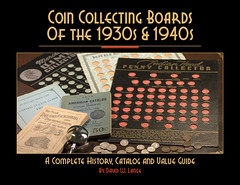 Visit my website: |
ON BOOKS THAT CONTAIN EXAMPLES OF THE NOTES BEING CATALOGED
Regarding the Long Branch, NJ Depression Scrip note I mentioned last week, Jamie Yakes writes:Joe Boling writes:
Near the end of the productions, one note was exhausted, so copies of that note had to be printed to glue into the book. That note now appears in dealer junk boxes as a replica/counterfeit (in black and white half-tone - it would fool nobody).
The book is Historical collections: Financial breakdown of Greece--April 1941-November 1944, published by The Establishment of Mining Credit Corporation, Athens, no date, no author. I don't know how many editions it went through. The one in front of me is a fifth edition piece, and it has all original notes in it.
Dave Lange writes:
David Gladfelter writes:
In this category too are the fractional currency presentation books described by Martin Gengerke in the ANA Centennial Anthology,
If you count reprints of currency then consider the Woodbury & Co. reprint of the “Great Locofoco Juggernaut” satirical note included in a book on this topic, which sometimes brings more by itself than when included in the book. Nolie Mumey’s book Colorado Territorial Scrip also has a reprint of a Clark Gruber & Co. note. These last two may be worth half credit?
QUERY: CSA SILVER INGOT INFORMATION SOUGHT
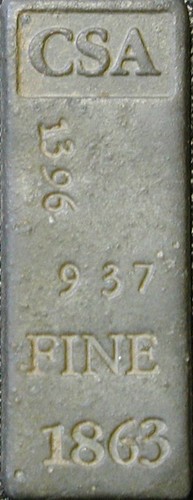

Tom DeLorey writes:
MERRY CHRISTMAS: SANTA CLAUS ON PAPER MONEY
Many thanks, and Merry Christmas to all!
-Editor
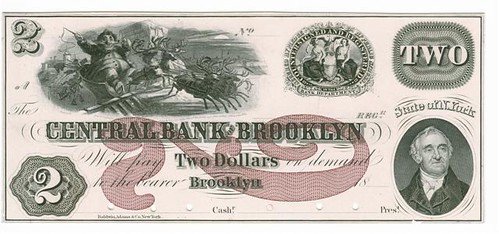
A rare Santa note that was purchased in the Christie's sale of the ABNCo archives in 1990. It also has a Lazy Deuce across the middle.
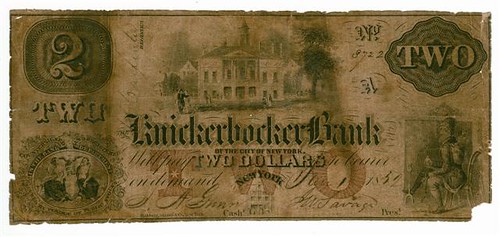
Only three of these are in existence, with one on a sheet. Low grade but very rare.
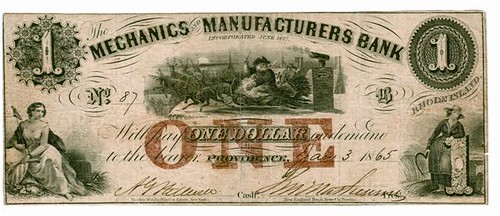
A Santa from Rhode Island

A scarce Milwaukee note with a vignette of Felix O. C. Darley's Santa at Bedside vignette. Only three notes are known with one in Krause, one in Durand and one in Wilson - collections

Another Santa Claus vignetted note.

Another Santa note from the 1990 archive sale.
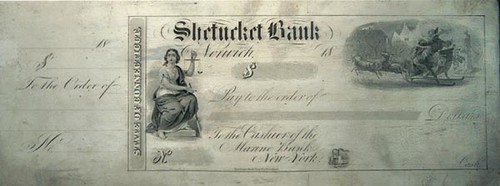
Here is the actual steel engraved plate for this Santa Certificate that we purchased from the ANR sale a few years ago. it was also used by the ABNCo for a souvenir card some years back.
To view a slide show of full-size photos, see: http://www.flickr.com/photos/coinbooks/sets/72157611408030662/show/
ARTICLE DESCRIBES NUMISMATIC EVIDENCE OF THE STAR OF BETHLEHEM
Astronomer Dave Reneke said the close proximity of Venus and Jupiter created a spectacle in the night sky just before the summer solstice that year. Britain's Telegraph newspaper reported that Reneke went so far as to suggest that perhaps Christmas should be celebrated on June 17 rather than December 25. An interesting idea, since the December Christmas celebration probably doesn't mark the true birth day of Jesus either. The December observance has its roots in a Roman celebration of the winter solstice.
The story in Matthew's Gospel seems to indicate that the people of Judea were oblivious to the Star. So, at least one scholar has taken a different approach to identifying the Star of Bethlehem.
"I set out to find what a stargazer of Roman times would have recognized as the star of a new Judean king," wrote retired Rutgers University astronomer Michael Molnar in the preface of his 1999 book, The Star of Bethlehem: The Legacy of the Magi.
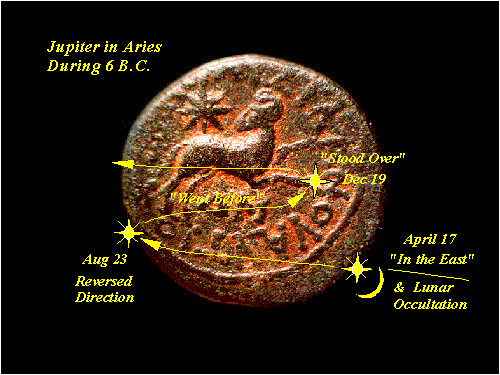
Owen Gingerich, professor emeritus of astronomy at Harvard University, thinks that Molnar is on the right track. "He has made a serious attempt to situate the Star in terms contemporary with the event, tying it in with numismatical evidence and Roman imperial horoscopes," he said. "Too many have tried to formulate the Star in modern terms, without considering the first century context."
Molnar said it was an ancient coin that initiated his Star quest. "That coin had Aries the Ram on it," he said in an interview. "My research of several astrological manuscripts from Roman times showed that the kingdom of Judea was represented by Aries the Ram."
Molnar's extensive research in primary sources led him to a set of conditions that "pointed like an astrological road sign to Jerusalem."
To read the complete article, see: Searching for the Star of Bethlehem (www.christianitytoday.com/ct/2008/decemberweb-only/151-51.0.html)
For more information on Molnar's book, see: Revealing the Star of Bethlehem (http://www.eclipse.net/~molnar/)
THE BOOK BAZARRE
QUERY: TED TURNER AND NUMISMATIC NECKWEAR
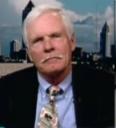 Did anyone else notice today what Ted Turner was wearing during his December 18th CNBC interview? Since I have a collection of numismatic ties it was the first thing I noticed. Mr. Turner's tie was a representation of a $10.00 Legal Tender Note (F114). It is one of the more colorful and popular numismatic neckties.
Did anyone else notice today what Ted Turner was wearing during his December 18th CNBC interview? Since I have a collection of numismatic ties it was the first thing I noticed. Mr. Turner's tie was a representation of a $10.00 Legal Tender Note (F114). It is one of the more colorful and popular numismatic neckties. I consider myself a bit of an expert in this area since my collection consists of about 50 different ties. Believe it or not there are even varieties in numismatic ties. I do have a dupe or two to trade.
To view the interview, see: Madoff & the Super-Rich (www.cnbc.com/id/15840232?video=970792002&play=1)
SUBSCRIBER PROFILE: JON RADEL
In last week's numismatic diary I mentioned the program for kids that I ran at the Annandale, VA coin show.Reader Jon Radel writes:
My son reported on the way home that he'd had a grand time at the show which, of course, included getting some goodies and getting a chance to explain what the four Lincoln cents next year are going to be "for." Thanks for putting that on.
It all got packed up for college and the following decades (some plastics are better than others for 20 years of storage)!
Meanwhile, I started collecting flags and books about them. And then my son, now 7, got interested in coins (thank you, state quarters and presidential dollars!) and dragged me (with very little resistance, mind you) back into coin collecting.
I largely focus, at the moment, on coins and bank notes of eastern Africa (I used to live in Kenya), Thailand, and modern local currencies (Berkshares, Lewes Pounds, Salt Spring dollars, etc.). The last in particular are an interesting challenge for research, and give me a feel for how banknote collectors must have felt before Dr. Pick came along.
I occasionally wonder where I'll find the time and money to collect everything I collect. Of course, having a very enthusiast fellow coin collector in the household is energizing....
I also collect the books about everything else I collect.
IRAQI SHOE-THROWING INCIDENT: SHADES OF THE WASHROOM WARRIOR
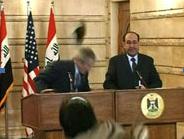
Barely 24 hours after the journalist, Muntader al-Zaidi, was tackled and arrested for his actions at a Baghdad news conference, the shoe-throwing incident was generating front-page headlines and continuing television news coverage. A thinly veiled glee could be discerned in much of the reporting, especially in the places where anti-American sentiment runs deepest.
In Sadr City, the sprawling Baghdad suburb that has seen some of the most intense fighting between insurgents and American soldiers since the 2003 invasion, thousands of people marched in his defense. In Syria, he was hailed as a hero. In Libya, he was given an award for courage.
In Saudi Arabia, a newspaper reported that a man had offered $10 million to buy just one of what has almost certainly become the world’s most famous pair of black dress shoes.
A daughter of Col. Muammar el-Qaddafi, the Libyan leader, reportedly awarded the shoe thrower, Muntader al-Zaidi, a 29-year-old journalist, a medal of courage.
To read the complete article, see: In Iraqi’s Shoe-Hurling Protest, Arabs Find a Hero. (It’s Not Bush.) (http://www.nytimes.com/2008/12/16/world/middleeast/16shoe.html)
The parallels are in the political controversy over the incident. Depending on one's political leanings for the victims, the acts can be seen as either heroic or cowardly and rude. The makers of the Washroom Warrior medal (and those heralding the Iraqi shoe-thrower) are in the hero camp. Many others of all political affiliations consider it a disgrace. But if a medal were to indeed be designed and struck to commemorate the incident, it would certainly be an interesting addition to numismatic lore.
One difference is that the Iraqi incident played out in public, in full view of witnesses and television cameras. The Huey Long incident, as described on the medal, was " PUBLIC ACCLAIM / FOR A DEED / DONE IN PRIVATE" -Editor
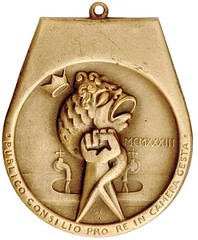 This greatly prized satirical medal commemorates an "accident" that befell Senator Huey "Kingfish" Long, easily one of the most corrupt politicians ever spawned.
This greatly prized satirical medal commemorates an "accident" that befell Senator Huey "Kingfish" Long, easily one of the most corrupt politicians ever spawned. It seems that on August 26, 1933 in Sands Point, Long Island, Long stumbled out of the men's room in a local establishment, his nose bloodied and his head dripping wet; he said he was attacked by a group of men, yet he was the only one in the washroom by the time his supporters entered and looked around.
Local legend has it that he was simply punched square in the face by an irate citizen of Louisiana, then forcibly dragged across the floor to have his head ceremoniously dunked in a porcelain plumbing receptacle. Commissioned by an unknown New York lawyer and designed by caricaturist George De Zayas (1894-1967), the original gold medal was struck by Medallic Art Company and given to the ANS in New York City to be presented to the actual perpetrator. He never showed to claim his gold medal; it has remained unclaimed for 75 years! Medallic Art also struck bronze replicas from the same dies.
Curiously, the U.S. Senate actually took up a collection to try to suppress this broadside at one of their own fine compatriots. More on this amusing incident in American political history can be read in The Numismatist, November 1933, pp. 704-705, and in Coins Magazine, November 1963, pg. 31.
Dave Bowers forwarded the following text from the Whitman 100 Greatest Tokens and medals book, which he coauthored with Katie Jaeger.
To read the earlier E-Sylum article on the topic, see: FEATURED WEB PAGE: 1933 HUEY LONG WASHROOM WARRIOR MEDAL http://www.coinbooks.org/esylum_v11n02a21.html
THE BOOK BAZARRE
ARTICLE PROFILES LOUISIANA COIN DEALER PAUL HOLLIS
An E-Sylum reader forwarded the following item. He writes: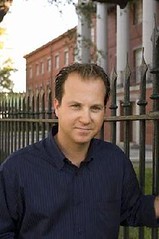 Paul Hollis has gotten accustomed to traveling with security guards flanking his sides.
Paul Hollis has gotten accustomed to traveling with security guards flanking his sides.No, he is not a movie star or significant political figure or the ruler of a nation… he’s in the coin business, and he’s your neighbor.
Rare coins may not be his name but collecting them certainly is the Mandeville resident’s game.
It all began at the ripe old age of 6 when Hollis’ grandmother presented him with his first coin. It was all it took for him to fall in love with coin collecting.
During his stint in New Orleans, the Metairie native traveled the nation and the world in search of rare coins. He also played a role in trading some of the most precious coins, including the 1913 Liberty nickel (only five were ever created), the 1804 dollar (more than a dozen known to exist), and the 1907 Ultra High Relief Saint Gaudens coin where only about two dozen are known to exist. Each coin traded for over a million dollars.
Today, Hollis runs his own company, Paul Hollis Rare Coins, with numerous high-dollar clients that include celebrities.
He’s also one of the leading authorities on 2,000-year-old coins that circulated during the time of Jesus Christ. With the large network of suppliers and contacts that are continuing to unearth the ancient coins in Jerusalem, Hollis is able to sell the currency at reasonable prices.
In 1844 the New Orleans mint struck a single ten-dollar gold coin proof known today as the 1844-O proof. Believed to be a gift for the incoming southern president, the coin went to auction in 1911 and sold for $50. Eighty years later it resurfaced and was finally traded to its current owner in 2006 for $1.5 million.
On loan from his client, Hollis is exhibiting the proof, insured for $2.5 million, at the historic New Orleans Mint till Jan. 18.
To read the complete article, see: Local coin collector leading authority on ancient coins (http://www.thesttammanynews.com/articles/2008/12/15/
northshore_life/community/doc49468232c7012715176974.txt)
SOUTH KOREA CANCELS PLANNED BANKNOTE OVER MAP MIXUP
It unveiled final designs of the 50,000 and 100,000 won bills late last year.
'The issuance of the 100,000 won banknote has been suspended because of problems with its design,' the official at the Ministry of Strategy and Finance told AFP on condition of anonymity.
The famous 19th-century map fails to include Dokdo, a group of islets in the Sea of Japan (East Sea) which are disputed with Japan.
Tokyo's renewed claim to the tiny islands sparked angry protests in Seoul this year.
Local news reports said, however, that the real reason for the postponement was the front design which features Kim Gu, a nationalist who led the anti-Japanese struggle during the 1910-1945 colonial era.
To read the complete article, see: SKorea shelves new banknote (http://www.straitstimes.com/Breaking%2BNews/
Asia/Story/STIStory_315903.html)
FEATURED WEB SITE: TASMANIAN PROMISSORY NOTES
This week's Featured Web Site is on Tasmanian Promissory Notes.From the web site (quoting Henry Melville in his History of Van Diemen's Land, 1835):

www.australianstamp.com/coin-web/
feature/numismtc/tasprom.htm

